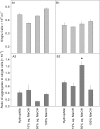Scent of danger: floc formation by a freshwater bacterium is induced by supernatants from a predator-prey coculture
- PMID: 20656874
- PMCID: PMC2937497
- DOI: 10.1128/AEM.01455-10
Scent of danger: floc formation by a freshwater bacterium is induced by supernatants from a predator-prey coculture
Abstract
We investigated predator-prey interactions in a model system consisting of the bacterivorous flagellate Poterioochromonas sp. strain DS and the freshwater bacterium Sphingobium sp. strain Z007. This bacterial strain tends to form a subpopulation of grazing-resistant microscopic flocs, presumably by aggregation. Enhanced formation of such flocs could be demonstrated in static batch culture experiments in the presence of the predator. The ratio of aggregates to single cells reached >0.1 after 120 h of incubation in an oligotrophic growth medium. The inoculation of bacteria into supernatants from cocultures of bacteria and flagellates (grown in oligotrophic or in rich media) also resulted in a substantially higher level of floc formation than that in supernatants from bacterial monocultures only. After separation of supernatants on a C(18) cartridge, the aggregate-inducing activity could be assigned to the 50% aqueous methanolic fraction, and further separation of this bioactive fraction could be achieved by high-pressure liquid chromatography. These results strongly suggest the involvement of one or several chemical factors in the induction of floc formation by Sphingobium sp. strain Z007 that are possibly released into the surrounding medium by flagellate grazing.
Figures






Similar articles
-
Aggregate formation in a freshwater bacterial strain induced by growth state and conspecific chemical cues.Environ Microbiol. 2010 Sep;12(9):2486-95. doi: 10.1111/j.1462-2920.2010.02222.x. Epub 2010 Apr 19. Environ Microbiol. 2010. PMID: 20406293
-
Protistan predation interferes with bacterial long-term adaptation to substrate restriction by selecting for defence morphotypes.J Evol Biol. 2016 Nov;29(11):2297-2310. doi: 10.1111/jeb.12957. Epub 2016 Sep 1. J Evol Biol. 2016. PMID: 27488245
-
Antibiotic effects of three strains of chrysophytes (Ochromonas, Poterioochromonas) on freshwater bacterial isolates.FEMS Microbiol Ecol. 2010 Feb;71(2):281-90. doi: 10.1111/j.1574-6941.2009.00800.x. Epub 2009 Oct 23. FEMS Microbiol Ecol. 2010. PMID: 19919604
-
Role of Microcolony Formation in the Protistan Grazing Defense of the Aquatic Bacterium Pseudomonas sp. MWH1.Microb Ecol. 2000 Apr;39(3):175-185. doi: 10.1007/s002480000026. Microb Ecol. 2000. PMID: 12035094
-
Feeding and growth of the marine heterotrophic nanoflagellates, Procryptobia sorokini and Paraphysomonas imperforata on a bacterium, Pseudoalteromonas sp. with an inducible defence against grazing.PLoS One. 2018 Apr 13;13(4):e0195935. doi: 10.1371/journal.pone.0195935. eCollection 2018. PLoS One. 2018. PMID: 29652905 Free PMC article.
Cited by
-
Coaggregation properties of trimeric autotransporter adhesins.Microbiologyopen. 2020 Oct;9(10):e1109. doi: 10.1002/mbo3.1109. Epub 2020 Aug 30. Microbiologyopen. 2020. PMID: 32864901 Free PMC article.
-
Escherichia coli Aggregates Mediated by Native or Synthetic Adhesins Exhibit Both Core and Adhesin-Specific Transcriptional Responses.Microbiol Spectr. 2023 Jun 15;11(3):e0069023. doi: 10.1128/spectrum.00690-23. Epub 2023 Apr 11. Microbiol Spectr. 2023. PMID: 37039668 Free PMC article.
-
Viral Aggregation: The Knowns and Unknowns.Viruses. 2022 Feb 21;14(2):438. doi: 10.3390/v14020438. Viruses. 2022. PMID: 35216031 Free PMC article. Review.
-
The Depletion Mechanism Actuates Bacterial Aggregation by Exopolysaccharides and Determines Species Distribution & Composition in Bacterial Aggregates.Front Cell Infect Microbiol. 2022 Jun 16;12:869736. doi: 10.3389/fcimb.2022.869736. eCollection 2022. Front Cell Infect Microbiol. 2022. PMID: 35782109 Free PMC article.
-
Biodegradation of microcystins during gravity-driven membrane (GDM) ultrafiltration.PLoS One. 2014 Nov 4;9(11):e111794. doi: 10.1371/journal.pone.0111794. eCollection 2014. PLoS One. 2014. PMID: 25369266 Free PMC article.
References
-
- Billen, G., P. Servais, and S. Becquevort. 1990. Dynamics of bacterioplankton in oligotrophic and eutrophic aquatic environments: bottom-up or top-down control? Hydrobiologia 207:37-42.
-
- Blom, J. F., K. Horňák, K. Šimek, and J. Pernthaler. 19 April 2010. Aggregate formation in a freshwater bacterial strain induced by growth state and conspecific chemical cues. Environ. Microbiol. [Epub ahead of print.] - PubMed
-
- Blom, J. F., and J. Pernthaler. 2010. Antibiotic effects of three strains of chrysophytes (Ochromonas, Poterioochromonas) on freshwater bacterial isolates. FEMS Microbiol. Ecol. 71:281-290. - PubMed
-
- Boenigk, J., K. Pfandl, and P. J. Hansen. 2006. Exploring strategies for nanoflagellates living in a ‘wet desert.’ Aquat. Microb. Ecol. 44:71-83.
-
- Caron, D. A., J. C. Goldman, and M. R. Dennett. 1988. Experimental demonstration of the roles of bacteria and bacterivorous protozoa in plankton nutrient cycles. Hydrobiologia 159:27-40.
Publication types
MeSH terms
LinkOut - more resources
Full Text Sources

